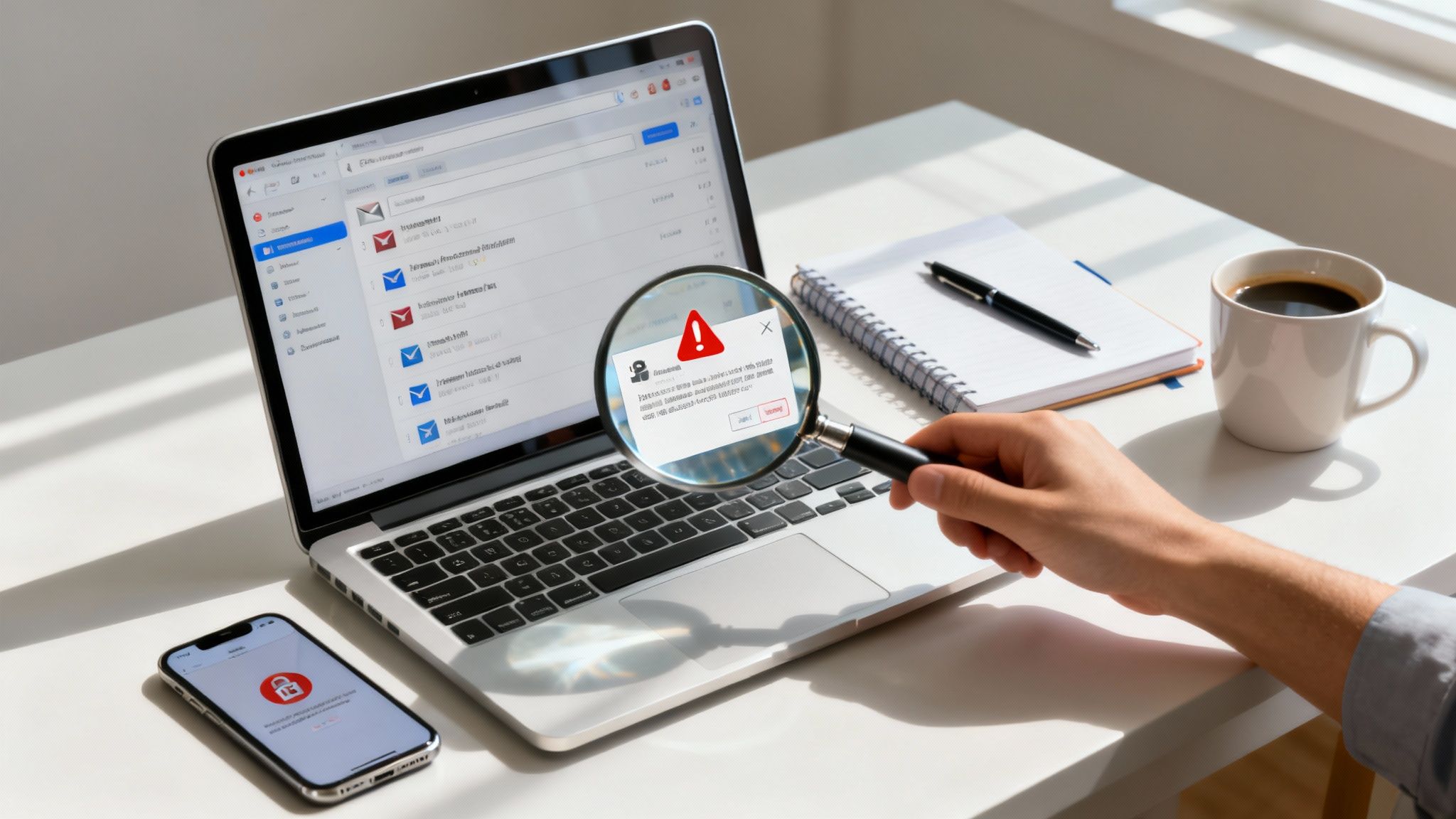· Digital Footprint Check · Content Marketing · 18 min read
Use a Free Digital Footprint Checker to Clean Your Past Effortlessly
Discover how a digital footprint checker free tool can help you manage and clean your online presence quickly. Start protecting your reputation today!

Before you even start looking for a digital footprint checker free of charge, let’s take a step back. It’s crucial to first wrap your head around what you’re looking for and, more importantly, why. Your online history isn’t just a random collection of old posts anymore. It’s the first impression you make on employers, lenders, and even new friends—it’s your modern-day resume.
Why Your Digital Footprint Is Your Modern Resume
Your digital footprint is so much more than your social media profiles. It’s a sprawling, interconnected web of data points that paints a surprisingly detailed picture of who you are. This covers everything from a forgotten comment on a blog post ten years ago to your public activity on professional networks.
In a world where 70% of employers admit to using social media to screen candidates before hiring, managing this presence isn’t paranoia. It’s just smart. You can learn more about the impact of your digital footprint on job opportunities in our detailed guide on the topic.
This digital resume is built from two very different kinds of information.
Active vs. Passive Footprints
Think of your active footprint as everything you knowingly share. It’s the data you put out there on purpose.
- Photos you post on Instagram
- Tweets you send out
- Professional updates you publish on LinkedIn
You are consciously curating this part of your online identity. You’re making deliberate choices about what you want the world to see.
Your passive footprint, on the other hand, is created without you even lifting a finger. This is the data collected behind the scenes as you browse the web. We’re talking about things like your IP address, your browsing history tracked by cookies, and location data gathered by apps on your phone. This hidden trail grows every single time you go online, and it’s often the most revealing part of your story.
The real power comes from understanding that both your active and passive footprints are combined by data brokers and search engines to create a single, unified profile of you—one that is often for sale.
This data aggregation is happening on a massive scale. To give you an idea of the money involved, the U.S. digital transformation market is projected to skyrocket to USD 1.66 trillion by 2030. That growth is fueled by the very data that makes up your footprint, which shows just how valuable it is and why controlling it matters so much. You can dive deeper into this trend in the full industry report.
For a quick visual, this screenshot from Wikipedia does a great job of breaking down the different pieces that make up your digital identity.

It clearly shows how everything—from your search history and online shopping to your social media interactions—merges to form your complete online persona. Recognizing these inputs is the first, most important step toward taking back control and making sure your digital resume reflects who you are today, not who you were years ago.
How to Find a Reputable Free Digital Footprint Checker
Trying to find a truly free digital footprint checker can feel like walking through a minefield. A lot of services promising a “free scan” are really just clever traps designed to harvest your data, not help you protect it. You have to know what you’re looking for and, more importantly, what to run from.
Start with a healthy dose of skepticism. Instead of typing in generic search terms, get more specific. Try searching for things like “privacy audit tools” or “free data breach scanner.” This simple trick often pushes tools from actual cybersecurity firms and privacy advocates to the top, burying the data-hungry marketing companies.
A legitimate tool will never ask for extremely sensitive information just to run a basic scan. Your name and email address? That’s pretty standard. But if a site immediately asks for your social security number or credit card details for a “free” check, that’s a massive red flag. Don’t hesitate—just close the tab.
Vetting the Tool’s Website
Before you hand over even a single piece of information, you need to do a little detective work. A trustworthy website will always have a few key elements that prove it’s legitimate.
First, hunt for a clear and easy-to-find Privacy Policy. This isn’t just legal fluff; it should spell out exactly what data they collect, how it’s used, and if they share it with anyone else. If you can’t find a privacy policy, or if it’s written in dense, confusing legalese, take that as a serious warning.
Next, look for an “About Us” page and real contact information. Legitimate companies aren’t afraid to tell you who they are. If the site feels anonymous and you can’t find a clear way to contact support or learn about the organization, it’s best to move on.
Pay attention to the website itself. Does it look professional? Reputable services invest in a clean user experience. Websites cluttered with pop-up ads, screaming sensationalist claims (“You’re 99% at risk!”), or high-pressure countdown timers are usually more interested in scaring you into a purchase than providing a real service.
Pro Tip: A genuine free tool provides value first. It should offer an initial scan or a specific feature (like an email breach check) without asking for payment, giving you actionable insights upfront.
Comparing Free Digital Footprint Scanning Methods
Not all free tools are created equal. Some are great for a quick check, while others offer a more focused look at specific risks. Knowing which type of tool to use for your situation is half the battle.
This table breaks down the common types of free scanning methods you’ll encounter:
| Tool Type | Primary Function | What It Finds | Best For |
|---|---|---|---|
| Email Breach Scanners | Checks if your email has been compromised in known data breaches. | Leaked passwords, personal details from specific breaches. | A quick, initial security check to see if your credentials have been exposed. |
| Username Checkers | Scans social media and other platforms for profiles using a specific username. | Public social media accounts, forum profiles, and other online personas. | Understanding your public visibility and finding old, forgotten accounts. |
| People Search Engines | Aggregates publicly available records from various online sources. | Addresses, phone numbers, relatives, and some public records. | Getting a sense of what data brokers might have on you from public sources. |
| Comprehensive Privacy Tools | Offers a broader, initial scan of your footprint across multiple areas. | A mix of data breach alerts, public profiles, and data broker mentions. | A good starting point for a more holistic view of your online exposure. |
While specialized tools are useful for specific tasks, a comprehensive privacy tool often gives you the best initial overview without needing to jump between multiple sites.
What to Expect from a Good Free Scan
So, you’ve found a tool that looks promising. What should you actually expect from that first free scan? A quality digital footprint checker free of charge will typically stick to information that’s already publicly available or part of known data breaches.

It should be able to pinpoint things like:
- Data Breaches: It will check if your email address has popped up in any known security breaches, alerting you to compromised accounts.
- Public Profiles: The scan should locate social media accounts or other public profiles linked to your name or email.
- Data Broker Mentions: Some of the more advanced free tools can even give you a peek into which data brokers likely have a profile on you.
This initial report is your starting point. Think of it as a snapshot. While free tools are great for identifying immediate threats, a truly exhaustive analysis often requires more powerful solutions. If you’re ready to dig deeper, you can explore some of the top tools for monitoring your digital footprint and keeping your data safe.
The real goal of a free scan isn’t to find every single trace of you online. It’s to highlight the most urgent risks so you can start taking back control.
Making Sense of Your Digital Footprint Report
So you’ve just run a scan with a digital footprint checker free of charge, and now you’re staring at a wall of information. It can definitely feel like a lot to take in—a weird mix of accounts you recognize, old forum posts you forgot existed, and entries from data brokers you’ve never even heard of.
The key is not to get overwhelmed. Instead, think of this report as a collection of puzzle pieces about your online life. Some pieces are totally harmless, like your public LinkedIn profile that’s perfectly up-to-date. Others are more concerning, like login details from a data breach on a site you used a decade ago. That online petition you signed in college? That goofy username from an old gaming forum? They’re probably in here, too. Your first job is to sort through it all.
This infographic breaks down how to turn that jumble of data into a clear plan.

As you can see, the path from a chaotic report to a prioritized cleanup strategy is a pretty straightforward, three-part process.
Your Three-Category Sorting System
To get a handle on your findings, I always recommend sorting them into three distinct piles. This simple framework helps you focus your energy where it actually matters, so you can tackle the biggest risks first.
Safe to Ignore: This is for data points that are accurate, intentionally public, and pose no real threat. Think of your professional profile on LinkedIn or a public comment you left on a major news site. These are just part of having a managed online presence and don’t require any action.
Review and Edit: This pile is for information that isn’t dangerous but might be outdated, unflattering, or just plain embarrassing. This could be an old MySpace profile with cringey photos, a public Amazon wish list, or a forum account with a silly username that can be traced back to you. The goal here is to update this content, make it private, or delete it to better align with who you are today.
Immediate Action Required: This is your high-priority pile. It includes any exposed sensitive information—passwords found in data breaches, old accounts with saved credit card numbers, or data broker listings that show your home address and phone number. These are direct threats to your privacy and security that need to be dealt with right away.
Your digital footprint isn’t just a collection of personal tidbits; it’s a vital part of a global digital economy now worth over $15 trillion. With the average person managing 7.6 social media accounts, every piece of data contributes to a larger profile used for everything from marketing to loan applications. You can find more fascinating stats about the scale of our collective digital footprints.
Spotting False Positives
As you sift through your report, you’re almost guaranteed to find some “false positives”—information that’s been incorrectly linked to you. This happens all the time, especially if you have a common name. For instance, if you’re named John Smith, the report might pull public records for dozens of other John Smiths across the country.
Look closely at the details. Does the location match? Is the email address one you’ve ever used? If the answer is no, you can confidently toss these items into the “Safe to Ignore” pile. Knowing how to spot these is crucial. It stops you from wasting time chasing down data that was never yours and lets you focus on the real threats to your privacy.
A Realistic Plan for Cleaning Your Online Presence
Once you have your prioritized report from a digital footprint checker free scan, the real work begins. It’s time to stop analyzing and start acting. This isn’t about a frantic, one-time purge; it’s about a methodical cleanup that puts you back in the driver’s seat of your online story.
The best place to start—and where you’ll see the most impact—is with anything flagged as “Immediate Action Required.” Almost always, this means old, unused accounts. Remember that photo-sharing site you tried once in 2012? Or that forum for a hobby you dropped years ago? These dormant profiles are ticking time bombs, often containing old passwords or personal details just waiting to be exposed in a data breach.
Deactivating and Deleting Old Accounts
First up, try to log into these old accounts. You’ve probably forgotten the password, which is fine—that’s what the “Forgot Password” link is for. Once you’re in, hunt around for the account settings. You’re looking for an option like “Deactivate” or “Delete Account.”
- Deactivation is often just a temporary measure. It might hide your profile, but your data is still sitting on the company’s servers.
- Deletion is what you’re really after. This permanently removes your information from their systems.
Always push for full deletion. Some services make this frustratingly difficult, burying the option deep in their settings or trying to guilt you into staying. Just be persistent.
Deleting old accounts is the digital equivalent of shredding old financial documents instead of just tossing them in the recycling. It’s a fundamental step in preventing your past data from being misused in the future.
Requesting Content Takedowns
But what about the stuff you don’t directly control? Maybe it’s an old photo on a friend’s blog or a mention of you on a small business website from a past job. For these, you’ll need to reach out directly to the site owner or the person who posted the content.
I’ve found that a polite, direct email is the most effective approach. Don’t be demanding or vague. Just clearly state who you are, provide a direct link to the content, and briefly explain why you’d like it removed.
Here’s a simple template that works well:
Subject: Content Removal Request
Hi [Webmaster Name],
My name is [Your Name], and I’m writing to request the removal of some personal information from your website. The content is located at this URL:
[Insert the exact URL here]
Specifically, I would like the [mention of my name / my photo / my comment] removed. Thank you for your time and assistance.
Sincerely, [Your Name]
This approach is professional and gets straight to the point. Most reasonable website owners will happily comply. For a more comprehensive look at tidying up your online presence, check out our complete guide on how to conduct a personal online audit.
Navigating Data Broker Opt-Outs
Now for the trickiest part of the cleanup: data brokers. These companies trade your personal information without ever asking for your consent, and opting out can feel like navigating a maze. Each broker has its own unique—and often intentionally confusing—removal process.
Some will have you fill out an online form, while others might ask for an email or even a physical letter. The key here is patience. Start with the big players like Acxiom, Epsilon, and Oracle. A quick search for “[Broker Name] opt-out” will usually lead you to their specific removal pages.
Unfortunately, this is an ongoing battle. Even after you successfully opt out, your data can pop up again from new sources. This is where regular monitoring is so important—a one-time cleanup is never a permanent fix. Your digital footprint checker free scan gave you the map; now you have to walk the path.
Proactive Habits for a Healthier Digital Footprint
 Cleaning up your digital past is a huge step, but the real victory is in protecting your future. It’s time to shift from a reactive cleanup to a proactive mindset, turning a one-time project into a lifelong skill. This is all about developing good “digital hygiene” so your online presence grows in a way you control.
Cleaning up your digital past is a huge step, but the real victory is in protecting your future. It’s time to shift from a reactive cleanup to a proactive mindset, turning a one-time project into a lifelong skill. This is all about developing good “digital hygiene” so your online presence grows in a way you control.
This doesn’t mean you have to lock down your online life. It’s simply about making conscious, informed choices that build a positive and professional footprint over time. A few simple habits can make an enormous difference.
Adopt a Quarterly Review Routine
Pop a reminder in your calendar every three months for a quick digital audit. This isn’t a deep dive; think of it as a simple maintenance check to catch small issues before they snowball.
- Run a ‘Vanity Search’: Search your full name in quotes (like “Jane Doe”) on a few different search engines. Just scan the first couple of pages of results for anything unexpected or unflattering that might have popped up.
- Check Your Key Social Profiles: Take a minute to review the privacy settings on your most-used social media accounts. Platforms are notorious for updating their policies, and a setting you thought was private might have quietly changed.
This quick routine keeps you aware of how you appear online, preventing nasty surprises down the road.
Master New Apps and Services Instantly
Whenever you sign up for a new app, service, or social media platform, make it a rule to master its privacy settings before you even post your first update.
Don’t just accept the default settings. Companies often configure them for maximum data collection, not maximum user privacy. Take two minutes to navigate to the privacy and security section and adjust things to your comfort level.
This habit is critical as our digital lives expand. With roughly 4.3 billion people using mobile devices, our footprints are constantly growing. This expanding presence is why over 50% of internet users are expected to be hit with targeted ads in 2024, as companies use this data for personalization. You can see more insights into how digital footprints are analyzed on Chargebacks911.com.
Build Your Digital Defense Wall
Finally, work a few simple defensive tactics into your daily online activities. These small actions create a surprisingly powerful barrier against data leaks and unwanted tracking.
- Use Email Aliases: Create separate, disposable email addresses for things like newsletters, online shopping, and signing up for services. This keeps your data in separate buckets and protects your main email from spam and data breaches.
- Be Wary on Public Wi-Fi: Try to avoid logging into sensitive accounts like your bank or primary email when you’re on an unsecured public network. If you absolutely have to, use a reputable VPN to encrypt your connection.
- Think Before You Share: Before posting, commenting, or even liking something, ask yourself one simple question: “Would I be okay with this being on a billboard next to my face?” If the answer is no, maybe reconsider.
By making these practices second nature, you stop needing a reactive digital footprint checker free scan and start building a healthier, more intentional online identity from the ground up.
Common Questions About Digital Footprint Checkers
Jumping into the world of free digital footprint checkers can bring up a few questions. That’s completely normal. Figuring out how these tools work, what to look for, and what to expect is the first step to using them safely and getting real value out of them. Let’s walk through some of the most common concerns I hear.
Are Free Digital Footprint Checkers Safe to Use?
For the most part, yes—reputable free checkers are safe, but you absolutely have to stay sharp. The biggest red flag is any tool that asks for incredibly sensitive information right out of the gate, like your social security number or credit card details, just to run a “free” scan. That’s a hard pass.
Legit tools from established cybersecurity or privacy companies don’t need that stuff. They work by scanning public records and known data broker lists, information that’s already out there.
Always, and I mean always, check the privacy policy before you give a tool any information. It should spell out exactly how they handle your data. If you can’t find one, or it’s written in confusing legalese, that’s your signal to back away and find a better option.
How Often Should I Check My Digital Footprint?
Consistency is way more important than frequency here. For a really deep dive with a dedicated tool, I’d suggest doing a comprehensive check once every six months or so, maybe once a year at a minimum. This gives you a good baseline and helps you spot any new information that’s popped up over time.
For more regular upkeep, a simple routine is your best friend:
- Quarterly Self-Search: Every three months, just pop your full name in quotation marks into a few different search engines. It’s a quick and easy health check.
- Life Event Checks: It’s also smart to run a check after big life changes. Think starting a new job search, moving, or getting married. These events often create new public records or online chatter.
This balanced rhythm keeps you in the loop without making you paranoid.
What if I Find Information I Cannot Remove Myself?
This is a tough one, and it happens. You’ll inevitably run into information that’s basically permanent—think public records, legitimate news articles, or content on a website where the owner has vanished. When you can’t get something taken down, the game changes from deletion to suppression.
The strategy here is to build up a wall of positive, professional content that you have complete control over. This is your digital PR campaign.
By creating a stellar LinkedIn profile, writing articles on a professional blog, or keeping your public social media accounts active and positive, you can start to push those negative or unwanted results further down the search page. The goal isn’t to make it disappear, but to bury it so deep that the odds of an employer or anyone else stumbling upon it become incredibly slim.
Ready to see what’s out there and start cleaning up your online presence? The free tools from Digital Footprint Check are a great place to begin. Get your free report today.
Article created using Outrank



